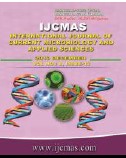


 National Academy of Agricultural Sciences (NAAS)
National Academy of Agricultural Sciences (NAAS)

|
PRINT ISSN : 2319-7692
Online ISSN : 2319-7706 Issues : 12 per year Publisher : Excellent Publishers Email : editorijcmas@gmail.com / submit@ijcmas.com Editor-in-chief: Dr.M.Prakash Index Copernicus ICV 2018: 95.39 NAAS RATING 2020: 5.38 |
Aspirational districts programme was launched by the government of India in 2017 to raise the living standards of people in 115 backward districts of the country by focusing on five key sectors which included among others health and nutrition. Nutritional status of children and socio-economic status in the ten aspirational district of Odisha were studied. Children in the aspirational districts were undernourished in all the three indicators: stunting, wasting and underweight as compared to the state average. The highest stunting (in percent) was prevalent in Nabarangapur (45.8) followed by Malkangiri (45.7), Balangir (44.4), Raygada (43.5) and Koraput (40.3). Nabarangapur (36.0 percent), Malkangiri (32.5 per cent), Korput (28.5), Balangir (26.1) and Kalahandi (24.8) had higher prevalence of 'wasting' children. Malkangiri district and Nabarangapur had over 50 percent underweight children and in five other districts (Balangir, Koraput, Kandhamal, Raygada and Nuapada) over 40 percent of children were underweight. The aspirational districts in Odisha are tribal dominated with lower literacy levels and a much higher gender gap in literacy and there is an urgent need for targeted approach by implementing the ICDS programme, Mid-day meal scheme etc. to address the incidence of child malnourishment.
 |
 |
 |
 |
 |